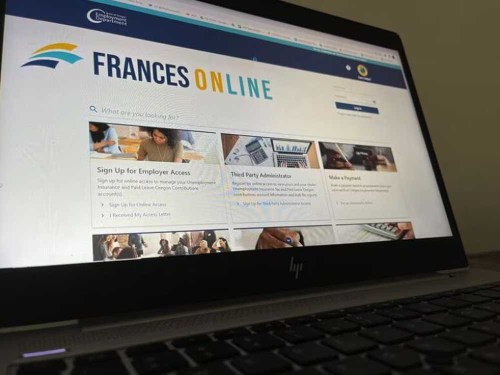Oregon paid leave, unemployment insurance stabilize after turbulent first year
Published 5:00 am Monday, September 23, 2024

- The Oregon Employment Department started launching its new online platform, Frances Online, in September 2022. The launch finished in March 2024.
IRRIGON — About a year after launching a new online platform for Oregonians to submit requests for paid leave and unemployment insurance, the program seems to be finding a rhythm.
Tabitha Chahla, of Irrigon, said she waited months for her requested medical leave payment to come through. Chahla was out on medical leave from her position as a forklift operator at a Home Depot garden center due to a necessary surgery, she said.
She filed in late March or early April, she said, and finally got her payment in mid-August, adding she was recently cleared for full-time work again. Chahla said she feels like her experience indicated a “system-wide failure” since it took so long and required so much effort on her end.
“It was frustrating for me personally because not getting any money that whole time was risking me being homeless just after having surgery,” she said. “I remember feeling like they wanted me to fail, like they wanted me to give up, and I could see how a person with less gumption would have given up.”
A rocky start
The Oregon Employment Department in September 2022 partially launched Frances Online, its new benefits system, because the computer system the agency had used was outdated and needed upgrading for more than a decade, according to Seth Gordon, communications officer for OED.
When the Oregon Legislature established Paid Leave Oregon, Gordon said, the program was folded into the modernization project for unemployment insurance. The Paid Leave Oregon portion rolled out in August 2023 with its expansion to unemployment insurance starting in March 2024. The paid leave program helps financially cover medical and family time off from work.
“It is a massive transition, massive upgrade, just taking into account all of the improvements technology-wise,” Gordon said. “Frances as a system, in the technical sense, its software and everything. The launch has been pretty smooth.”
But for the unemployment insurance and the paid leave claims, the transitions have been tougher. During the coronavirus pandemic, Gordon said, claims increased dramatically and the department hired staff to meet that need.
At one point, the department had 1,200 employees, but now, he said, there are about 400 staff members dealing with a similar number of claims as the department had with double or triple the staff. He said OED requested additional staffing prior to launching Frances Online, but it wasn’t approved during the legislative session, so the funding wasn’t approved until right around when the new program was launched. That made for a messy transition.
“We want to recognize the reality that is our funding and staffing situation and we acknowledge the challenges that we face,” Gordon said, “and we also recognize how important these benefits are to people, that this is a safety net, and that the people applying for benefits are very much in need and we have recognized that we need to do better and we’ve taken numerous steps to do that.”
Increasing the pace
On the Paid Leave Oregon side of Frances, thousands of claims are made each week. Between Aug. 14 and 27, said Jack Patterson, communications officer for Paid Leave Oregon, the program received 136,000 claims and paid out almost $600,000 in benefits. And for a while, he said, they just didn’t have the staff to keep up with claims as quickly as they wanted to.
“There are definitely folks who had longer tail end delays with their applications,” Patterson said. “There’s generally always a reason for that, but I can say, high-level, we are pretty proud to report we’ve reduced the number of open claims older than six weeks by over 86%, so our customers are way less likely than they were at the launch of the program to experience particularly long waits.”
Echoing Gordon, Patterson also said after the pandemic, the employment department had “some real intense staffing attrition and workload” to deal with while launching a new program at the same time, which put the entire department “under quite a bit of strain.”
The average wait time to resolve claims now is 29 days, which was reached through a combination of closing the phone lines on Mondays so people could dedicate more time to work on and process applications and following up with employers, as well as hiring staff trained for phone-based customer service. The new staff started at the beginning of the summer, for the most part, which helped with reducing the overall number of claims by 46%, according to Patterson.
“While we are stressing how we want this to be a good user experience, we also ask our customers to understand this isn’t something that can happen immediately or overnight,” Patterson said. “We’ve got some work to do and we’ve done a lot of work to make sure that Frances (Online) is as easy a customer service experience as possible.”









